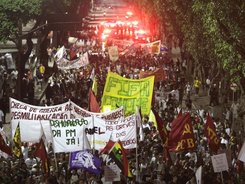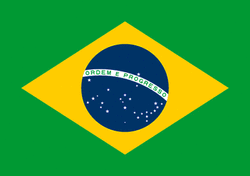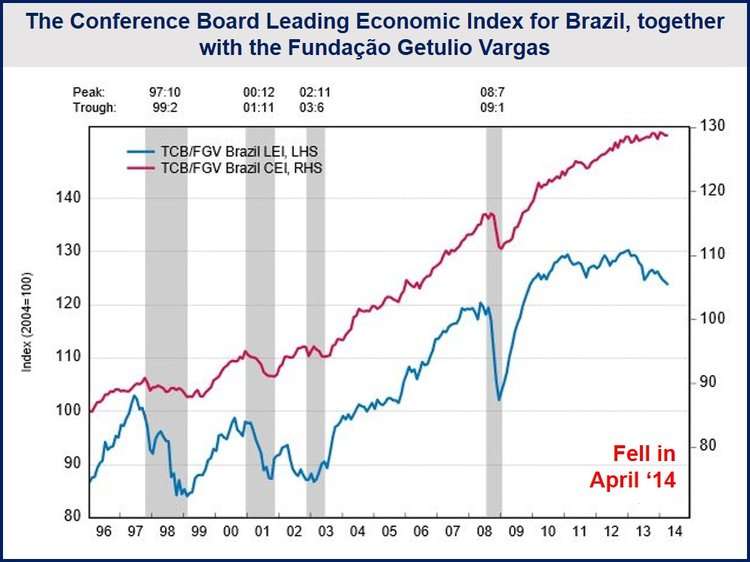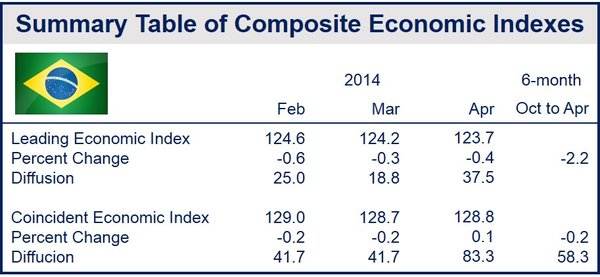Brazilian pessimism grows as its Leading Economic Index (LEI) fell -0.4% in April, 2014, after declining -0.3 in March and -0.6 in February. In fact, it was the fourth successive month of decline. Brazil’s LEI now stands at 123.7 (2004=100).
Brazil’s LEI is created by The Conference Board and the Fundação Getulio Vargas (FGV).
Of the eight components that make up the LEI, four of them contributed positively to April’s result.
Brazilian pessimism grows in industry, services and among consumers
Paulo Picchetti, Economist at FGV/IBRE, said:
“A more favorable external scenario helped stock prices and the trade balance in April, but this modest improvement wasn’t enough to overcome the increasing pessimism of entrepreneurs from the industrial and services sectors, and of consumers facing inflationary pressure.”
“Overall, the LEI continues to suggest that Brazil’s bleak economic situation is unlikely to improve in the upcoming months.”
Ataman Ozyildirim, Economist at The Conference Board, added, “April’s decline in the LEI for Brazil, the fourth consecutive drop, pushes the six month growth rate deeper into negative territory and increases the likelihood that economic activity will decelerate in the near term. Continued deterioration in business and consumer sentiment and political uncertainty remain obstacles to an already struggling Brazilian economy.”
(Source: The Conference Board)
The manufacturing, service sector, and consumer surveys were significant negative contributors to the decline in April, as they were during the previous months.
Including April’s decline, the LEI has fallen -2.2% (approximately -4.4% annual rate) during the October 2013 to April 2014 period, more steeply than the -1.9% drop (approx. -3.8% annual rate) for the previous six months.
Weaknesses among the leading indicators have become widespread, with all the components falling during the last six months.
The positive contributors to LEI in April, in order of size, were:
- Stock prices.
- The exports volume index.
- The swap rate (inverted).
- The terms of the trade index.
The negative contributors to LEI, in order of size, were:
- The services sector survey: expectations index.
- The manufacturing survey: expectations index.
- The consumers survey: expectations index.
- The consumer durable goods production index.
(Source: The Conference Board)
Brazil CEI up 0.1% in April
Brazil’s Coincident Economic Index (CEI), which measures current economic activity, rose by +0.1% in April to 128.8 (2004=100), after falling -0.2% in March and -0.2% in February.
Of the six components that make up the CEI, four contributed positively to April’s index.
Over the six month period to the end of April the CEI declined -0.2% (approx. -0.5% annual rate), in contrast to a +0.3% gain during the previous six months.
Brazil’s real GDP (gross domestic product) grew by +2.8% annualized in Q4 2013, compared to (minus) -2.1% annualized in Q3 2013.
The positive contributors to CEI in April, in order of size, were:
- Occupied employed population.
- Shipments of corrugated paper.
- The volume of sales of the retail market index.
- Workers’ average income.
Industrial energy consumption and industrial consumption remained unchanged in April.
According to The Conference Board:
“The Brazil LEI has been falling since the beginning of this year, and its six-month change has fallen deeper into negative territory, with very widespread weaknesses among its components.”
Meanwhile, the six-month change in the Brazil CEI turned negative for the first time since mid-2013. The persistent and widespread weaknesses among the leading indicators suggest that the rate of economic activity is likely to decelerate in the coming months.”
World Cup unlikely to provide significant boost

Brazil hosts the World Cup in June/July 2014. According to a Reuters poll, the tournament will only provide a modest boost to Brazil’s sluggish economy. However, it may improve the country’s reputation for tourism and business, despite delays in getting stadiums ready and fears of street demonstrations.
The tournament is expected to add just 0.2 percentage point to Brazil’s GDP growth in 2014, according to estimates by 116 economists, not really enough to kick-start the economy out of its four-year slowdown.
During the last World Cup, which took place in South Africa, Brazil’s GDP was growing at 7.5% per year. It is expected to expand by just 1.7% in 2014.



